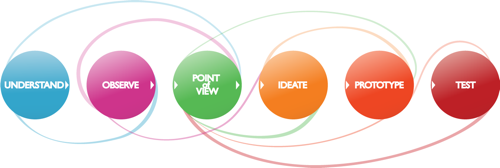I am a big believer in differentiated learning. Our students come in too many shapes and sizes to think that they can all find success on one learning path.
As a result, I am not a fan of rigid pacing or textbooks, both of which, I think, take a one-size-fits-all approach.
This month I am taking an IDEO course called “Design Thinking for Educators.” The basic idea of design thinking is to address ill-defined, messy problems through a process of defining needs, researching them further, brainstorming (ideation), prototyping, implementation, and iteration.
Key to design thinking are empathy, creativity, collaboration, experimentation, and iteration. It’s thinking out of the box for real-life, messy problems.
Credit: Stanford K-12 Lab, CC BY SA
Human learning is certainly a messy problem that calls for empathy and creativity, so it seems to me that this might be a useful way to look at curriculum or, more broadly, learning experiences:
- Look at the challenge. Gather information. Talk to the student, parents, teachers, and others to understand the unique needs. Observe. Empathize. Reflect.*
- Interpret the observations made to begin to define the needs of the learner.*
- Ideate. Brainstorm. Collaborate. Come up with as many possible ways address the needs as possible.*
- Take the ideas and experiment with them through rapid prototyping.*
- Try something out. Test the prototype. Gather data about what’s working. (Yeah, yeah, I know…)*
- Iterate and evolve over time. Human learning is messy. Things change, and the learning process needs to respond to these changes.*
* Throughout this process, get feedback and collaborate with others.
So this sounds like individualized education plans or personalized learning with a new design twist. This idea is not particularly new, but what might be different now is the advent of new technologies coupled with open educational resources as tools for achieving this vision.
Imagine having a personalized learning plan for each learner and the tools to realize it cost-effectively. How could we ever go back to pacing and textbooks after that?


The devil is in the abstraction–look, gather, empathize, reflect, interpret, ideate, brainstorm, collaborate, rapid prototype, test, iterate, and evolve.
And the devil is in being given the power to do this rather than having to seize it sub rosa like my wife and I had to do when we unschooled our kids starting 25 years ago. If we had been given the power then to work with the school system instead of separate from it, much more could have been done by both us and them.
Yet…you are right. We do have the power to do this now. What you are describing is what unschoolers have been doing for a very long time. Now the tools to connect are much more robust. The friction between learners and the object of their work is so much less now than ever before. As far as curriculum is concerned I consider it to be a very dark word indeed. Originally it meant a race course. Now it means a course to race, a series of left hand turns over a designated number of circuits until ‘done’. The assumptions tacit to that are what make it so dark. So dark that the term ‘extra-curricular’ defines everything outside of the hamster course that school has become.
I believe that the change will come, but that it will either be what James Howard Kuntsler calls ‘the long emergency’ or it will be a complete collapse due to other circumstances–diesel fuel prices, for example. This edu-apocalypse is already here in some places (Detroit, Oakland, Chicago) but it is just not evenly distributed yet. We need design thinking that embraces the apolyptic change that is coming to a neighborhood near you.
Lots of food for thought in this response, Terry. I’m coming to expect that from you. :) Thanks.
I think we have to seize the power (agency is a big part of design thinking), but also believe that we can do this within the framework of school as we know it. Call me naive or a pollyanna, but there is actually a federal funding push right now around personalized learning. That’s exactly what this is. (Yes, I know that the same feds are pushing for standardization and RTTT, but we have to take the opportunities where they exist. That might be through specialized programs like this on a district basis…or through just closing your door and doing good things where you can. There are pockets of this going on already.)
Re: curriculum, to me, curriculum is a learning path, nothing more or less. We have to customize those learning paths to each student, whether in or outside of school.
We can’t wait for the apocalypse.